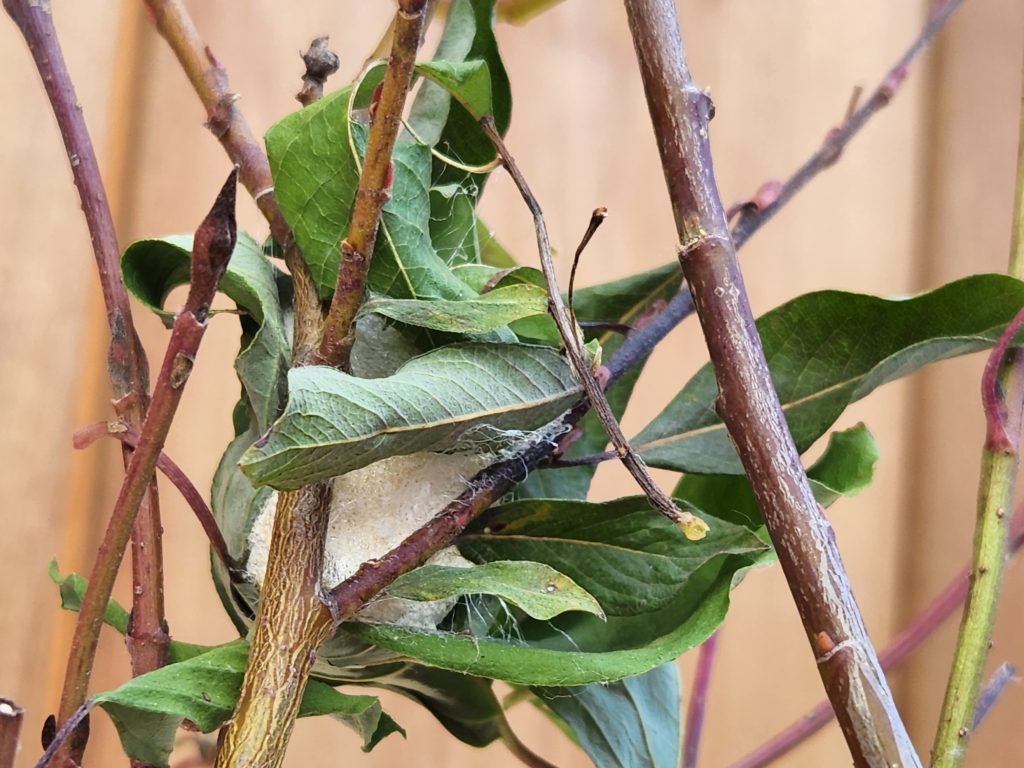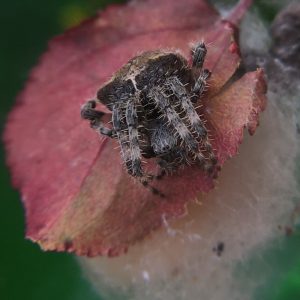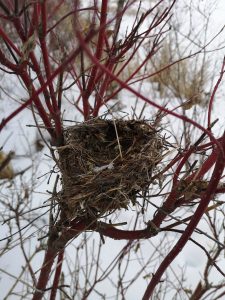My BIG Alberta Backyard – NatureHood

A clump of leaves that appears to be stuck on the branch could be hiding something like this polyphemus moth cocoon! STEPH WEIZENBACH
BY STEPH WEIZENBACH, PROGRAM DIRECTOR
Alberta is a great place to live. It’s a big, beautiful province full of all kinds of natural wonders. In My Big Alberta Backyard, we introduce you to the unique and interesting wild spaces, and the diversity of wildlife that live there, that you can find in your province. This time, let’s explore your “NatureHood!”
What Is My NatureHood?
As defined by our partner, Nature Canada:
Your NatureHood is any green space in your neighbourhood — from the biggest cities to the smallest towns. It’s nearby nature, whether it be the park at the end of your street, your backyard, a community garden plot, an overlooked urban forest, or a special green space in your community.
Your NatureHood is any place you go to “connect” with the Earth’s natural wonders — from watching a bee pollinate a flower, to feeding wild birds, to witnessing the trees change with the passing of the seasons.
Many people travel 15 minutes, half an hour, or even several hours to their favourite park or natural area to connect with nature. But exploring your own NatureHood can give you a wonderful new feeling of connection to — and appreciation for — nature in your own community.

Orb weaver spider on a leaf, on top of its recently laid, pink, fluffy egg sac. STEPH WEIZENBACH
Find Some Bugs
Get down on your hands and knees in your NatureHood. Stay in one spot for a while and look closely. Suddenly, you will see the bugs scuttling and crawling all around you. You can take pictures of the bugs and post them on iNaturalist to find out what species they are! Follow the instructions at naturealberta.ca/inaturalist to find out how to get started.
Have a look in corners and crannies and you might find a cat face spider (also known as an orb weaver) with an egg sac that looks like a fuzzy, spider-sized pillow. Look for ladybugs and count the spots on their elytra (protective wing cases). Spot a small clump of leaves that haven’t fallen from the branch and you may have discovered a moth cocoon!
Secrets Revealed by Fallen Leaves
The leaves have all turned yellow, orange, or red, and are crunching underfoot. Raking up the leaves into a pile, throwing them up into the air, and running and jumping in the leaves is a long-held tradition for many generations of Albertans. If you are new to Alberta, I promise that no one will look at you funny if you bring your rake for a walk in your local NatureHood to make a pile of leaves to play in!

Empty bird nests are easy to spot once all of the leaves have fallen. Have a peek to find out what they are made of. STEPH WEIZENBACH
When you are done crunching and playing in the leaves, take some time to look up into the trees where the leaves have fallen from. The leaves’ absence reveals many secrets from the past summer. Songbird nests stick out like a sore thumb, now that they aren’t hidden by a bunch of green leaves. See one? The nestlings who hatched here last summer have already grown feathers and learned to fly. The nests are empty. It’s the perfect time to get up close to take a peek.
What is the nest made of? Birds build nests using a variety of materials, including small twigs, moss, pieces of long grass, fluff from last year’s cattails, and possibly even a tuft of fur that your dog rubbed off on a fence. Have a close look, but please leave the nest intact and undisturbed. Many birds return to the same spot year after year, and some will rebuild on top of a previous nest. The most exciting thing about this revelation is that you have discovered where to search — carefully and quietly — next summer to find a nesting bird. You and nature share your very own secret!
Have you spotted any large clumps of twigs and grass high up in the tree branches? It might look like a giant bird nest, but it is actually a drey. What is a drey, you ask? Visit our Fun Facts to find the answer!
This article originally ran in Nature Alberta Magazine - Fall 2022.
